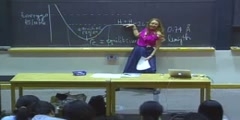Lec 35 - Understanding Molecular Structure and Energy through Standard Bonds
"Lec 35 - Understanding Molecular Structure and Energy through Standard Bonds" Freshman Organic Chemistry (CHEM 125) Although molecular mechanics is imperfect, it is useful for discussing molecular structure and energy in terms of standard covalent bonds. Analysis of the Cambridge Structural Database shows that predicting bond distances to within 1% required detailed categorization of bond types. Early attempts to predict heats of combustion in terms of composition proved adequate for physiology, but not for chemistry. Group- or bond-additivity schemes are useful for understanding heats of formation, especially when corrected for strain. Heat of atomization is the natural target for bond energy schemes, but experimental measurement requires spectroscopic determination of the heat of atomization of elements in their standard states. 00:00 - Chapter 1. The Limits of Molecular Mechanics Programs 07:32 - Chapter 2. The Cambridge Structural Database and the Demands of Predicting Bond Characteristics 21:36 - Chapter 3. Calculating Chemically Useful Heats of Formation 42:17 - Chapter 4. Measuring Heats of Atomization with Bond Energies Complete course materials are available at the Open Yale Courses website: http://open.yale.edu/courses This course was recorded in Fall 2008.
Video is embedded from external source so embedding is not available.
Video is embedded from external source so download is not available.
Channels: Chemistry (General)
Tags: Heat of Formation heat of atomization average bond energy
Uploaded by: yalefreshorganic ( Send Message ) on 05-09-2012.
Duration: 48m 42s
Here is the next lecture for this course
Chemical Science - Free Energy of Formati ...
47:47 | 20099 viewsLec 36 - Bond Energies, the Boltzmann Fac ...
47:51 | 4309 viewsChemical Science - Bond Energies / Bond E ...
47:24 | 27583 viewsLec 33 - Conformational Energy and Molecu ...
47:53 | 3896 viewsLec 31 - Preparing Single Enantiomers and ...
48:53 | 3266 viewsLec 85 - Heat of Formation
12:35 | 3442 viewsChemical Science - Covalent Bonds - Lectu ...
47:12 | 16585 viewsLec 13 - Overlap and Energy-Match
49:44 | 3120 viewsLec Last - Potential Energy Surfaces, Tra ...
47:44 | 7209 viewsKey Concepts of Heat and Enthalpy
08:41 | 6552 viewsHow does a heat pump work
02:48 | 6366 viewsHeat Engines
04:36 | 3856 viewsWorking of Heat Engines
04:36 | 6374 viewsLec 1 - Physics 10 Atoms and Heat
01:14:00 | 3202 viewsLec 2 - Physics 10 Atoms and Heat II
01:04:06 | 3266 viewsNo content is added to this lecture.
This video is a part of a lecture series from of Yale
Lecture list for this course
Lec 2 - Force Laws, Lewis Structures and Resonance
Lec 3 - Double Minima, Earnshaw's Theorem and Plum-Puddings
Lec 4 - Coping with Smallness and Scanning Probe Microscopy
Lec 6 - Seeing Bonds by Electron Difference Density
Lec 7 - Quantum Mechanical Kinetic Energy
Lec 8 - One-Dimensional Wave Functions
Lec 9 - Chladni Figures and One-Electron Atoms
Lec 10 - Reality and the Orbital Approximation
Lec 11 - Orbital Correction and Plum-Pudding Molecules
Lec 12 - Overlap and Atom-Pair Bonds
Lec 13 - Overlap and Energy-Match
Lec 14 - Checking Hybridization Theory with XH_3
Lec 15 - Chemical Reactivity: SOMO, HOMO, and LUMO
Lec 16 - Recognizing Functional Groups
Lec 17 - Reaction Analogies and Carbonyl Reactivity
Lec 18 - Amide, Carboxylic Acid and Alkyl Lithium
Lec 19 - Oxygen and the Chemical Revolution (Beginning to 1789)
Lec 20 - Rise of the Atomic Theory (1790-1805)
Lec 21 - Berzelius to Liebig and Wöhler (1805-1832)
Lec 22 - Radical and Type Theories (1832-1850)
Lec 23 - Valence Theory and Constitutional Structure (1858)
Lec 24 - Determining Chemical Structure by Isomer Counting (1869)
Lec 25 - Models in 3D Space (1869-1877); Optical Isomers
Lec 26 - Van't Hoff's Tetrahedral Carbon and Chirality
Lec 27 - Communicating Molecular Structure in Diagrams and Words
Lec 28 - Stereochemical Nomenclature; Racemization and Resolution
Lec 29 - Preparing Single Enantiomers and the Mechanism of Optical Rotation
Lec 30 - Esomeprazole as an Example of Drug Testing and Usage
Lec 31 - Preparing Single Enantiomers and Conformational Energy
Lec 32 - Stereotopicity and Baeyer Strain Theory
Lec 33 - Conformational Energy and Molecular Mechanics
Lec 34 - Sharpless Oxidation Catalysts and the Conformation of Cycloalkanes
Lec 36 - Bond Energies, the Boltzmann Factor and Entropy
Lec Last - Potential Energy Surfaces, Transition State Theory and Reaction Mechanism















